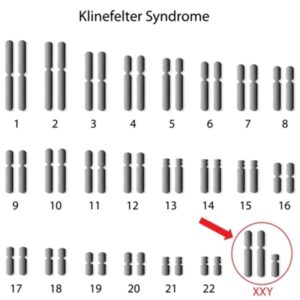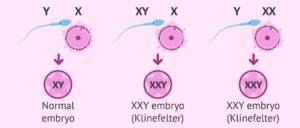Summary
Klinefelter Syndrome also known as 47, XXY syndrome, KS, XXY syndrome, or XXY trisomy is a chromosomal condition that affects intellectual and physical properties in males. An average male’s genetics will have one X and one Y chromosome, except this is different if you have Klinefelter Syndrome. This syndrome is a genetic condition where a male is born with an additional X chromosome. A few symptoms of Klinefelter are breast growths and cancers, infertility and learning difficulties, and osteoporosis. There are ways to improve the person’s way of life which include: emotional and physical therapy, and hormone replacement. 75% of men that have the condition go undiagnosed.

Description
Symptoms:
There are two main types of symptoms- physical and intellectual. Physical symptoms include: being born with a smaller penis, undescended testicle, abnormal body proportions, flat feet, fusion of certain bones in the forearms, coordination problems, testicular failure, increased breast tissue, increased risk for blood clots, weaker bones, and infertility. Typically, males with Klinefelter syndrome have small testes and a lower amount of testosterone. Testosterone is an essential hormone in the development of a male without it there can be delays in puberty or incomplete puberty, breast enlargement, decreased muscle mass, decreased bone density, and a reduced amount of facial and body hair. With less hormone production males may become infertile. Intellectual symptoms include depression and anxiety, social and behavioral issues, impulsive behaviors and emotional immaturity, learning disabilities, and ADHD.
Diagnosing and treatment:
Diagnosing Klinefelter Syndrome can happen in one of the following ways: screening before birth, testing once symptoms appear, karyotype blood test, or fertility testing. Not every pregnancy gets tested for the condition, but tests are done and gather genetic materials from tissue or fluid that can be tested. Chorionic villus and Amniocentesis are sample sites with genetic material from the baby and can help determine if the baby has Klinefelter syndrome. Sense KS is part of a person’s genetic code there is no cure or way to get rid of the conditions completely. Symptoms can only be managed to improve a person’s way of life. Hormone replacement, therapy, and surgery are the only ways of treatment at this time. Sadly, there is no way to prevent this condition as it is a genetic error. This syndrome cannot be inherited, and parents can do nothing to prevent their children from having Klinefelter syndrome.
Genetics:
Klinefelter syndrome occurs during the formation of reproductive cells in one of the parents. A normal male has 46 chromosomes; a copy of one X and one Y chromosome (46, XY). A normal female has two copies of the X chromosome (46, XX). Klinefelter Syndrome is a genetic condition that creates an extra X chromosome in a male’s genetic coding. Now adding another X chromosome there would be a total of 47 instead of the typical 46 chromosomes. Two copies of the X chromosome and one copy of the Y (47, XXY) Nondisjunction occurs during cell division preventing the X chromosome from being split up normally among the cells. A sperm fertilizes an egg with an extra X with one Y the child will have the condition. Just like if sperm has both an X and Y fertilized with an egg with one X they too will have Klinefelter syndrome.
News Articles
- https://www.technologynetworks.com/diagnostics/news/oldest-case-of-klinefelter-syndrome-diagnosed-in-ancient-skeleton-365159 This article goes into detail about a newly found ancient skeleton with Klinefelter syndrome. It explains the analyzing methods that had to be done to make the syndrome discovery.
- https://www.healthgrades.com/right-care/symptoms-and-conditions/klinefelter-syndrome?hid=exprr_v1 This article creates a good understanding of Klinefelter syndrome. The article talks about the symptoms, causes, and effects, diagnosing, treatment options, and more frequently asked questions.
- https://www.livescience.com/men-with-extra-sex-chromosomes-study This article talks about how men may carry KS and not even know. The research was done and people were shocked to find just how common Klinefelter Syndrome is.
Reference List
“Klinefelter Syndrome”; Cleveland Clinic;https://my.clevelandclinic.org/health/diseases/21116-klinefelter-syndrome
“Klinefelter Syndrome”; MedlinePlus;https://medlineplus.gov/genetics/condition/klinefelter-syndrome/#inheritance
“15 Most Common Klinefelter Syndrome Symptoms”; McAfee; https://simplyhealth.today/15-most-common-klinefelter-syndrome-symptoms/?utm_source=klinefelter%20syndrome&utm_medium=15MostCommonKlinefelterSyndromeSymptoms&utm_campaign=adw_us&msclkid=6e554e71676a15edfdf62d646aaa48c0